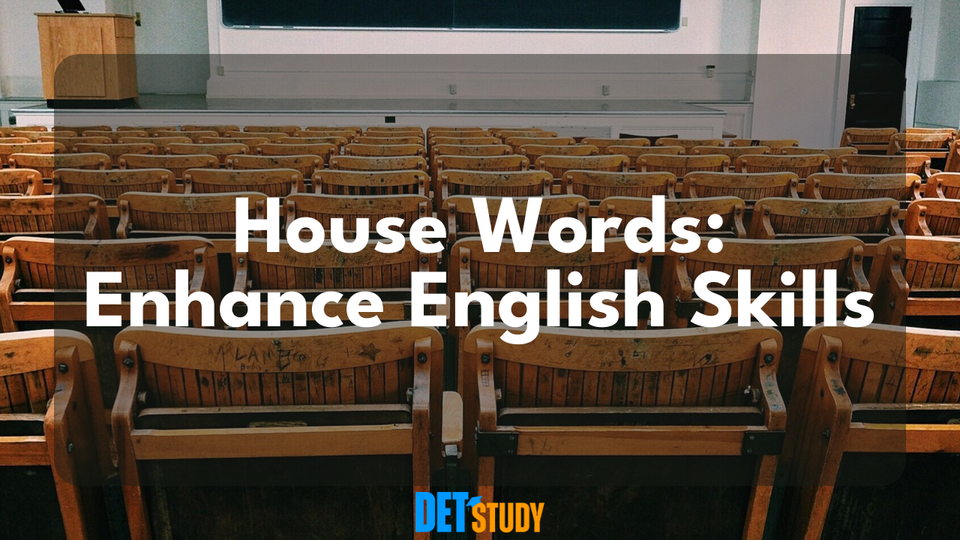House Vocabulary: Essential Words to Enhance Your English Language Skills

When learning a new language, familiarizing yourself with vocabulary related to everyday topics is essential. One such topic is the house, a place where we spend much of our time. Here, we introduce you to some common house-related vocabulary to help you describe different parts of a house and identify common household objects.
Rooms in the House
-
Living Room: This is the room where families often gather to relax and entertain. It might have a sofa, a television, and other furniture like chairs or coffee tables.
-
Kitchen: The heart of the home, the kitchen is where meals are prepared. You'll find appliances like a stove, refrigerator, and microwave here.
-
Bedroom: A private room for sleeping. A typical bedroom might contain a bed, a dresser, and a wardrobe or closet for clothes.
-
Bathroom: This room contains facilities like a toilet, a sink, and often a shower or bathtub.
-
Dining Room: A room used for eating meals. It usually has a dining table and chairs.
-
Laundry Room: A space where clothes are washed, often equipped with a washing machine and dryer.
-
Garage: An area for storing vehicles or tools, often attached to the house.
Common Household Objects
-
Furniture: Items such as sofas, tables, and chairs are commonly found in various rooms of the house.
-
Appliances: Machines such as a refrigerator, stove, oven, and dishwasher help perform everyday tasks.
-
Bedding: Includes items like sheets, blankets, and pillows used on a bed.
-
Utensils: Tools like forks, knives, and spoons used for eating and preparing food.
-
Electronics: Gadgets including televisions, radios, and computers found in many homes.
Useful House Vocabulary
- Wall: The vertical structure that encloses or divides rooms.
- Ceiling: The overhead surface covering a room.
- Floor: The lower surface you walk on in a room.
- Window: An opening in a wall, usually fitted with glass, to let in light or air.
- Door: A hinged or sliding barrier used to close and open entrances to rooms or buildings.
Adjectives to Describe a House
- Spacious: A large and roomy area.
- Cozy: Warm and comfortable.
- Modern: Equipped with new and up-to-date features or furniture.
By becoming familiar with these words, you can more effectively communicate and describe the living spaces in English. Practice using this vocabulary in sentences to enhance your language skills further.
Rooms and Areas of a House
When learning English, it’s helpful to know common vocabulary related to different parts of a house. This will make it easier to describe where you live or talk about different homes. Here is a list of essential terms related to rooms and areas you might find in a typical house:
Kitchen
- Stove/Oven: An appliance used for cooking food.
- Refrigerator: A large appliance that keeps food and drinks cold.
- Sink: A basin with a tap used for washing dishes and hands.
Living Room
- Sofa/Couch: A comfortable seat for two or more people.
- Coffee Table: A low table placed in front of a sofa.
- Television (TV): An electronic device for watching programs.
Bedroom
- Bed: A piece of furniture for sleeping.
- Wardrobe/Closet: A space or piece of furniture for storing clothes.
- Nightstand: A small table next to a bed.
Bathroom
- Shower: A place where a person stands under running water to wash.
- Bathtub: A large container that can be filled with water for bathing.
- Toilet: A fixture used for getting rid of bodily waste.
Dining Room
- Dining Table: A table where meals are served and eaten.
- Chairs: Seats typically placed around a dining table.
Hallway
- Hallway: A long passage with doors leading to different rooms.
Attic
- Attic: The space or room located just below the roof of a house, often used for storage.
Basement
- Basement: The floor of a building which is partly or entirely below ground level.
Garden/Yard
- Garden/Yard: An outdoor space usually with grass, plants, or flowers.
Garage
- Garage: A building or part of a building where vehicles are kept.
Understanding these terms will help you navigate conversations about homes more comfortably. You can practice by identifying these spaces and items within your own home and using their names in sentences.
Common Household Items and Furniture
Learning the vocabulary for household items and furniture is essential for discussing daily life and making yourself understood in a home environment. Below is a list of common items you would typically find in various rooms of a house.

Living Room
- Sofa/Couch: A comfortable seat for multiple people.
- Armchair: A chair with supports for your arms.
- Coffee Table: A low table placed in front of a sofa.
- Bookshelf: A piece of furniture with horizontal shelves for books.
- Television (TV): An electronic device for watching shows and movies.
- Rug: A piece of thick woven material used to cover part of a floor.
Kitchen
- Stove/Oven: An appliance used for cooking food.
- Refrigerator (Fridge): An appliance used to keep food and drinks cold.
- Sink: A basin used for washing hands and dishes.
- Microwave: A device for quickly heating food.
- Cabinet: A piece of furniture for storing cups, dishes, or food.
- Tableware: Items used at the table, such as plates, bowls, knives, and forks.
Bedroom
- Bed: A piece of furniture for sleeping.
- Wardrobe/Closet: A storage area for clothes.
- Dresser: A piece of furniture with drawers for storing clothes.
- Nightstand: A small table beside a bed used to hold items like a lamp or clock.
- Lamp: A device that emits light; often found on a nightstand.
- Pillow: A soft cushion used to support your head while sleeping.
Bathroom
- Toilet: A fixture for human waste disposal.
- Shower: A place for people to bathe while standing.
- Bathtub: A large container for holding water in which you can sit and bathe.
- Sink: A bowl that is attached to the wall in a bathroom, used for washing hands and face.
- Towel Rack: A bar or frame where towels are hung to dry.
- Mirror: A glass surface that reflects an image.
Dining Room
- Dining Table: A table for eating meals.
- Chairs: Seats found around the dining table.
- Buffet/Hutch: A piece of furniture used for storing dining essentials like plates and cutlery.
- Centerpiece: An ornamental object placed in the center of a dining table.
Learning these terms will help you navigate conversations about the home and improve your understanding of written and spoken English concerning domestic spaces.
What To Know About The Duolingo English Test (DET) Scoring SystemAppliances and Electronics
Understanding the vocabulary for common appliances and electronics in a house is essential for daily communication and convenience. Here's a list of terms and a brief description of each to help you become familiar with these household items:
Kitchen Appliances
- Refrigerator: A large appliance used to keep food and drinks cold.
- Oven: A device used for baking or roasting food.
- Stove: Also known as a cooktop, it is used for cooking with pots and pans. It usually has multiple burners or heat sources.
- Microwave: A small appliance that uses microwaves to heat or cook food quickly.
- Dishwasher: A machine for washing dishes, cutlery, and kitchen utensils.
- Blender: An appliance used to mix, puree, or blend food and liquids.
Laundry Appliances
- Washing Machine: A machine used for washing clothes and other textiles.
- Dryer: An appliance used to remove moisture from washed clothes by using heat.
Living Room Electronics
- Television (TV): A device for viewing video content, often used for entertainment and news.
- Remote Control: A handheld device used to operate electronic equipment from a distance.
- Speakers: Devices that emit sound, often used in conjunction with a stereo system or computer.
Office Electronics
- Computer: An electronic device for processing data, often used for work, study, or entertainment.
- Printer: A machine that prints text and images on paper.
- Router: A device that connects different networks and routes data between them, often providing internet access in the home.
Bedroom Electronics
- Alarm Clock: A clock with a signal (usually a sound) that can be set to wake someone up at a specific time.
- Lamp: A device for giving light, often with a bulb and a shade, used in the bedroom for reading or as ambient light.
Cleaning Appliances
- Vacuum Cleaner: A device that uses suction to remove dirt and dust from floors, carpets, and other surfaces.
- Iron: An appliance used to press clothes to remove wrinkles.
Learning the names and uses of these common appliances and electronics will help you navigate English conversations about household items more effectively.
Exterior Features and Outdoor Spaces
Understanding the vocabulary related to the exterior of a house and its outdoor spaces can enrich your English learning experience and help you describe homes more vividly. Here are some key terms to get you started:
Exterior Features
- Facade: The front of a building, often the most detailed and decorative part.
- Roof: The top covering of a building, protecting it from weather. It can be flat, sloped, or even have a special design like a gable or hip.
- Chimney: A vertical structure through which smoke from a fireplace or stove is expelled.
- Door: The entryway to a house. It can be made of wood, glass, or metal, and may have a doorbell or a knocker.
- Window: An opening in the wall that allows light to enter and people to see outside. It can include various types like bay windows, sash windows, or casement windows.
- Garage: An enclosed space for parking cars, which can be attached to the house or separate.
- Porch: A covered area at the entrance of a house, often with steps leading up to it.
- Balcony: A platform on the outside of a building, above ground level, enclosed by a railing.
- Gutter: A channel along the edge of a roof for carrying off rainwater.
- Driveway: A private road leading from the street to a house or garage.
Outdoor Spaces
- Garden: An area laid out with flowers, shrubs, and trees, often surrounding the house.
- Lawn: A stretch of grass in a garden or yard, usually kept neat and trimmed.
- Patio: A paved outdoor area adjoining a house, often used for dining or recreation.
- Deck: A flat, wooden surface extending from the back of a house, similar to a patio but typically made of timber.
- Fence: A structure that encloses an area, commonly made of wood, metal, or wire.
- Yard: The land around a house, often divided into front yard and backyard.
- Pool: A swimming pool offers a place for relaxation and enjoyment, often found in a backyard.
- Shed: A small building used for storage, often found in a garden or backyard.
- Pond: A small body of water, typically found in gardens, filled with fish or aquatic plants.
- Pathway: A paved or unpaved track for walking, often leading to the house or through the garden.
By familiarizing yourself with these terms, you'll be better equipped to discuss and describe homes in English, especially focusing on their exterior features and delightful outdoor spaces.
DET Study provides an extensive suite of over 15,000 practice questions, focusing on leveraging adjectives and adverbs to fortify your grammatical skills. Regular practice with these targeted materials ensures that you approach the Duolingo English Test with enhanced confidence and precision, ready to achieve your desired scores.
🎯 Need more practice? Check out DETStudy.com for expert resources, 15,000+ practice questions, and AI-powered writing and speaking feedback.
Frequently Asked Questions (FAQ)
What is the difference between a "terrace" and a "balcony"?
What is considered a "loft" in house vocabulary?
How does a "basement" differ from a "cellar"?

